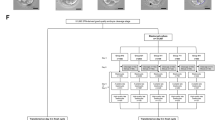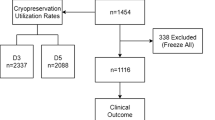Abstract
Purpose
To assess the variables that may predict which cleavage-stage embryo may develop into a blastocyst, and vice versa, to determine whether the cleavage-stage embryo morphology should be taken into consideration when transferring the embryo at the blastocyst stage.
Methods
A single center, retrospective cohort study. The study cohort included 3072 patients undergoing 3607 retrieval cycles and 23,124 embryos at the cleavage stage. We assessed the blastulation rate and evaluated which variables impact the ongoing pregnancy rate.
Results
High blastulation rate correlates with higher embryos' grading (I > II > III > IV > V) and higher number of blastomeres (8 > 7 > 6 > 5 > 4). 949 patients had fresh single blastocyst transfers. The ongoing pregnancy rate was 28.9% per transfer. Patients with ongoing pregnancies were significantly younger (34.3 vs. 36 years, p < 0.001), had higher number of oocyte yield (9.8 vs. 9, p = 0.02), and an increased rate of good-quality embryos transferred (70.7% vs. 47.7%, p = 0.001). When evaluating embryos progression, we found that whenever embryo developed to a good-quality blastocyst, its appearance at the cleavage stage did not affect ongoing pregnancy rate.
Conclusion
Higher the number of blastomeres and better embryo grading were found to correlate with a higher blastulation rate. Nevertheless, if the embryo has already developed to a top-quality blastocyst, its morphology at the cleavage stage did not impact ongoing pregnancy rate.
Similar content being viewed by others
References
Majumdar G et al (2017) Relationship between morphology, euploidy and implantation potential of cleavage and blastocyst stage embryos. J Hum Reprod Sci 10(1):49–57
De Vos A et al (2016) Cumulative live birth rates after fresh and vitrified cleavage-stage versus blastocyst-stage embryo transfer in the first treatment cycle. Hum Reprod 31(11):2442–2449
Glujovsky D et al (2016) Cleavage stage versus blastocyst stage embryo transfer in assisted reproductive technology. Cochrane Database Syst Rev 6:CD002118
Martins WP, Nastri CO, Rienzi L, Van Der Poel SZ, Gracia CR, Racowsky C (2016) Obstetrical and perinatal outcomes following blastocyst transfer compared to cleavage transfer: a systematic review and meta-analysis. Hum Reprod 31(11):2561–2569
Racowsky C et al (2000) The number of eight-cell embryos is a key determinant for selecting day 3 or day 5 transfer. Fertil Steril 73(3):558–564
Xiao JS et al (2019) When only one embryo is available, is it better to transfer on day 3 or to grow on? Reprod Biomed Online 39(6):916–923
Haas J et al (2019) What is the optimal timing of embryo transfer when there are only one or two embryos at cleavage stage? Gynecol Endocrinol 35(8):665–668
Heitmann RJ et al (2013) The simplified SART embryo scoring system is highly correlated to implantation and live birth in single blastocyst transfers. J Assist Reprod Genet 30(4):563–567
Barrenetxea G et al (2005) Blastocyst culture after repeated failure of cleavage-stage embryo transfers: a comparison of day 5 and day 6 transfers. Fertil Steril 83(1):49–53
Karaki RZ et al (2002) Blastocyst culture and transfer: a step toward improved in vitro fertilization outcome. Fertil Steril 77(1):114–118
Schroder AK et al (2004) Cumulative pregnancy rates and drop-out rates in a German IVF programme: 4102 cycles in 2130 patients. Reprod Biomed Online 8(5):600–606
Glujovsky D et al (2012) Cleavage stage versus blastocyst stage embryo transfer in assisted reproductive technology. Cochrane Database Syst Rev 7:CD002118
Schwarzler P et al (2004) Pregnancy outcome after blastocyst transfer as compared to early cleavage stage embryo transfer. Hum Reprod 19(9):2097–2102
Zhao H et al (2020) Clinical outcomes following frozen-thawed blastocyst transfers with blastocysts derived from different cell numbers on day 3: a retrospective cohort study. J Assist Reprod Genet 37(3):641–648
Shapiro BS, Harris DC, Richter KS (2000) Predictive value of 72-h blastomere cell number on blastocyst development and success of subsequent transfer based on the degree of blastocyst development. Fertil Steril 73(3):582–586
Luna M et al (2008) Human blastocyst morphological quality is significantly improved in embryos classified as fast on day 3 (> or = 10 cells), bringing into question current embryological dogma. Fertil Steril 89(2):358–363
Vermey BG et al (2019) Is there an association between oocyte number and embryo quality? A systematic review and meta-analysis. Reprod Biomed Online 39(5):751–763
van Loendersloot LL et al (2010) Predictive factors in in vitro fertilization (IVF): a systematic review and meta-analysis. Hum Reprod Update 16(6):577–589
Verberg MF et al (2009) The clinical significance of the retrieval of a low number of oocytes following mild ovarian stimulation for IVF: a meta-analysis. Hum Reprod Update 15(1):5–12
Sunkara SK et al (2011) Association between the number of eggs and live birth in IVF treatment: an analysis of 400 135 treatment cycles. Hum Reprod 26(7):1768–1774
Aizer A, Haas J, Shimon C, Konopnicki S, Barzilay E, Orvieto R (2020) Is there any association between the number of oocytes retrieved, women age, and embryo development? Reprod Sci. https://doi.org/10.1007/s43032-020-00391-4
Author information
Authors and Affiliations
Contributions
EZ: principal investigator, designed the study, wrote the paper and edited it in all its revisions. RC and RO: participated in designing the study, retrieved the data, performed the statistical evaluations, proof read the paper and took part in discussions regarding the results. AV: retrieved the data, proof read the paper and took part in discussions regarding the results. EB: retrieved the data, proof read the paper and took part in discussions regarding the results. JM: retrieved the data, proof read the paper and took part in discussions regarding the results. JH: participated in designing the study, assisted in writing the paper and edited it, proof read the paper and took part in discussions regarding the results.
Corresponding author
Ethics declarations
Conflict of interest
The authors report no conflict of interest.
Ethical approval
The study protocol was approved by the Institutional Review Board, Veritas IRB 16304-17 on February 5th, 2019.
Informed consent
It was a retrospective study and therefore informed consent was not needed. This retrospective study included 3607 women undergoing IVF during the years 2016–2018 and the patients are not ongoing treatments in the present. We collected the data from our databases and did not perform any intervention.
Additional information
Publisher's Note
Springer Nature remains neutral with regard to jurisdictional claims in published maps and institutional affiliations.
Rights and permissions
About this article
Cite this article
Zilberberg, E., Casper, R., Meriano, J. et al. Cleavage vs blastocyst stage embryos: how are they interrelating?. Arch Gynecol Obstet 304, 1083–1088 (2021). https://doi.org/10.1007/s00404-021-06003-z
Received:
Accepted:
Published:
Issue Date:
DOI: https://doi.org/10.1007/s00404-021-06003-z




